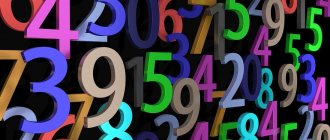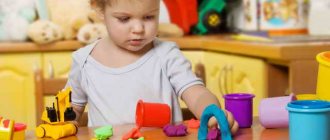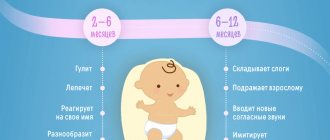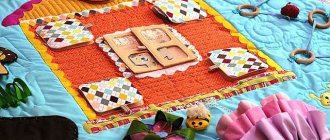What seems elementary to an adult is often new, unusual and incomprehensible to a child. Writing numbers in words is not an easy task and requires preliminary preparation. What is important is not so much an example of how to do it correctly, but the gradual development of graphomotor skills - training the muscles of the phalanges of the fingers, honing small movements, good orientation in the notebook sheet and the cell itself, understanding the meaning of numbers. It makes sense to develop this skill at the age of 5–7 years, not earlier.
Teaching methods
At the moment, the following methods exist:
- Mathematical copybooks (hatching, writing numbers and printed geometric shapes) - designed for joint work between teacher and student. They consist of separate, varied and fun lessons that, in a playful way, help you master writing the numbers from 0 to 9, starting with individual parts and ending with whole numbers. The copybooks differ in color and black and white, cell sizes (small and wide), as well as additional tasks and exercises for the development of logic, thinking, attention and explanations for adults.
- Dotted numbers are one of the most popular methods, allowing the student to quickly and effortlessly remember how to write a particular number. The essence of the training is that the adult is required to put dots or lines in the shape of a number, which the child will have to connect with each other.
- Counting sticks, matches, pencils and other elements are the best way to help kids add the outlines of numbers.
Equally important when teaching the basics of mathematics are number cubes, dominoes, puzzles and other learning materials.
Solving the pen holding problem
You can write with either a pen or a pencil. The diameter of the pen should not exceed 1 cm, preferably no longer than 15 cm. Personally, I used triangular (hexagonal) short pencils and non-slip ballpoint pens.
To develop the skill of “holding with three fingers,” the “BOAT” game helps well (Fig. 1). The fingers of the hand are bent into a loose fist as if we were holding a small glass. The thumb and index fingers touch, forming a “boat” shape. We place the pen in the “boat” so that its writing end lies at the junction of the thumb and forefinger, and the other end at the junction of the roots of these fingers in the hollow. The end of the handle protrudes from the fingernails at a distance of 1-2 cm. The middle finger goes under the thumb. On the command: “Drop anchor!”, the index and thumb are spread apart. The pen (pencil) falls on the middle finger. You need to hold the handle with your thumb and forefinger so that the “anchor” does not drag the “boat” under the “water.” Select the length of the pencil so that its writing end outweighs the blunt end.
The end result is that the end of the pen rests on the middle finger, and the index and thumb squeeze it from the sides. The “anchor” is firmly clamped by the “ground”. You can draw, for example, an anchor.
At the command “Raise anchor” the handle is brought to its original position. We play several times until the anchor drawings turn out beautiful. An adult plays with a child and shows how to draw an anchor.
Rice. 1. "Boat"
Preparation
The main thing when learning is meaningfulness.
- First, parents should conduct oral instruction before writing numbers. Graphic writing of numbers should not be something abstract. The child is required to be able to count to 10, as well as recognize this or that number in printed form.
- Secondly, the baby should be familiarized with the cage. For the first lesson, it is enough to draw a small cell on a landscape sheet and show its center, corners and sides, and also teach the preschooler to find the upper and lower boundaries, all sides of the cell and divide it into four equal parts.
- Thirdly, you should start learning directly after the child can independently draw all the individual elements of a number - sticks, ovals, semicircles and dashes.
Direction of writing numbers
The best age for starting to learn calligraphic writing is considered to be 5-6 years.
What should a child be able to do?
The child should be familiar with tracing the contours of various shapes and lines, be able to color images and confidently hold pencils in their hands.
The student should easily trace the dotted line sticks and hooks.
The correct placement of the hand is also important. A preschooler should know how to accurately hold a pen and sit at a table.
A child who has perfectly developed fine motor skills can easily master writing lessons. Excellent trainers for fingers are modeling from plasticine, polymer clay, salt dough and drawing in an album (from ordinary scribbles to meaningful plot drawings).
Many young mothers begin to get bored while on maternity leave from a series of monotonous tasks. How not to go crazy while on maternity leave? Choose a hobby and develop yourself.
How to put your baby to sleep in 5 minutes? Read useful tips here.
You can see the options for crafts made from matchboxes at the link.
Teaching numbers in a playful way
The light, interesting and bright environment allows the baby to easily remember numbers from 0 to 9 and grasp new material on the fly. Success in learning will be more noticeable if the adult does not focus on the lesson itself, but presents the topic being studied in passing.
After the preschooler gets acquainted with a certain number, it should be drawn on a landscape sheet, preferably in an enlarged size. If desired, the number can be colored with a colored pencil. Further, joint fantasies of the child and the adult are welcomed.
Plasticine numbers
You can make a number from plasticine, roll out puff pastry or any other baking dough, cut out the required number from it and bake in the oven. The baby’s mother can be 100% sure that her son or daughter will not only eat the number she personally prepared with great pleasure, but will also remember the baked number for the rest of her life.
Multi-colored cubes, cards or circles with images of numbers are perfect for reviewing the material covered. The adult should be shown the required element, and the child should accurately guess the required number.
Cookies “Units”
Kids prefer “want” to the word “need,” so each new number should be perceived with enthusiasm. Otherwise, the baby will develop an aversion to learning, which will certainly lead to problems at school.
Wishes
To prevent children from developing an aversion to writing numbers, as well as letters, play these numbers with them according to the rules and images described above. Do not overload with volume and exercise equipment. Better take their own orders. Let them set tasks for themselves, determine when and how many simple numbers they can write, or, as “craftsmen.”
If a child has mastered different ways of writing, then he has developed good self-regulation, and he can easily master beautiful writing of numbers. Only for this he needs to have a desire.
And desire arises from play, creativity, interest in achieving a visible goal indicated by criteria. This is exactly the approach I used to perform such routine work as “writing numbers.”
Good luck to those who want to use this technique.
About the author : Efremov Sergey Vladimirovich, TRIZ teacher, author of articles and books on the problems of teaching children of preschool and primary school age.
Are you interested in the material? Share on social media and leave a comment below:
- Tweet
- Telegram
Learning by association
Abstract numbers mean nothing to a child; for this reason, visual representations are the best way to help children remember certain numbers with ease. For example, a baby’s mother can compare the number 2 with the figure of a swan, 0 with the letter O or a circle, 8 with a matryoshka, etc.
There are several types of associative methods:
- The hanger method helps children remember certain numbers by assigning each number a visual image or a specific word (for example, 1 is an athlete, 5 is an image of a school, 15 is an athlete participating in school competitions).
- Comparing numbers with a specific image - 0 looks like a ball, a sun, a circle; 1 is a toothpick, straw, flashlight, etc.
- O'Brien's method - connecting numbers with the names of famous people. The main principle of the association is number – person – action. For example, 1 is Agnia Barto, 5 is a writer, and already the number 15 is a person who writes poetry.
- Rhymes are combinations of numbers with a certain consonance of words or rhymes.
The child should be taught one associative technique that seems most convenient and easy to remember for an adult. Otherwise, the student will get confused in a large number of difficult-to-understand techniques for memorizing images.
Learning numbers using time and calendar
This method is a type of associative method: each number becomes a kind of reminder for daily activities (for example, seven is wake-up time, nine is kindergarten, three is tea with cookies, five is a walk, etc.).
An excellent replacement for a watch is a calendar with a moving window. Any upcoming event is shown to the baby. The adult must allow the student to manage the calendar independently.
Counting calendar
Naturally, the more colorful the new learning material is, the better the numbers are remembered. Moreover, the numbers in the calendar allow you to teach kids how to count to 31 without much difficulty.
For a more interesting learning experience for adults, it is advisable to prepare a large, bright watch with a round dial and multi-colored numbers. Instead of a calendar, you can keep a diary, come up with a special book of notes or a schedule.
Copybooks
Mathematical copybooks are not just ready-made contours needed for tracing.
The purpose of training is to teach the baby to maintain the correct tilt.
That is, the number 1 should not be written with a vertical stick, but should be started from the middle of the cell, drawn with an inclined line to the upper right corner and smoothly lowered to the lower center.
Copybook assignments allow you to teach your child not only to write numbers correctly and strengthen counting skills from 0 to 9, but also to navigate checkered sheets, develop graphic skills, logical thinking and visual perception. Regular writing activities help improve hand coordination and fine motor skills.
Russian copybooks differ from American and other foreign textbooks, since the principles of writing ones, sevens and nines have some differences.
How to keep your child from losing interest
- Don't start practicing writing numbers if your child is in a bad mood or doesn't show interest.
- Let your learning to write take the form of a game. A kind of school game. You can place the toys and tell them together with the baby, they can also be “students” who may also not succeed.
- Alternate activities. First we wrote the numbers, then we had a break where we could play and at the same time relax our fingers.
- Praise your child during class, even if, in your opinion, his writing is clumsy.
- Start learning with simple tasks.
- Don’t sit with your child until the bitter end. 15 minutes a day will be enough. If the baby can’t stand it that much, then don’t insist.
Writing rules
The first numbers should be shown to the baby on a large sheet of paper. An adult needs to be patient and thoroughly explain to the student the various details of the numbers (straight and wavy lines, oval, semicircle) and the rules for writing them: where to start the line, in which direction to go, when to lift the pen from the sheet and where to end.
So:
- Number 1 – you need to start from the center of the cell, move smoothly to the upper right corner and lower it to the center of the cell.
- Number 2 – starts just below the middle of the center of the cell. The point is drawn in a line upward and then rounded in the upper right corner of the cell, drawn downward with a slant to the left and ends with a lower wavy line.
- Number 3 is two semi-oval lines. It needs to start from the middle of the cell, lead with a curve to the upper right corner, lower it down just above the middle of the cell and repeat the oval, leading to the lower left corner.
- Number 4 - starts from the middle of the top cell, runs a straight line down to the middle, continues to the right, but not to the end, and ends with a long stick, which starts from the upper right corner and ends in the middle of the cell.
- Number 5 - consists of three parts: a straight line from the upper middle of the cell to its center, a semicircle on the right side of the cell and the final upper wavy line, which is drawn from left to right.
- Number 6 is written in one continuous line; the pen should not be lifted from the sheet of paper. The number starts with a semi-oval from the upper right corner of the cell, draws a line to the bottom, rounds it into a circle at the bottom and ends just above the center of the cell.
- Number 7 - starts with a wavy line just to the left of the upper side of the cell, goes to the right and drops in a straight line to the middle of the lower side, which at the end must be crossed out with a long straight stick.
- The number 8 is drawn in an oval line from the middle of the left side of the cell, moves in a semicircle to the right side, touching its side, smoothly falls to the left and is again rounded into the middle of the cell, touching the starting point of the number.
- Number 9 – starts from the middle of the right side of the cell, goes up, smoothly rounds to the starting point, then the line with a bend descends to the lower part of the middle of the cell.
- Number 0 – represents an oval and starts from the middle of the right side of the cell, goes up, goes down and returns to the starting point.
At 3 years old, a child begins to try to do everything on his own, but he does not always succeed. Psychologists identify a crisis at the age of 3 in a child. At this moment, parents should be especially attentive to changes in the baby’s behavior.
We make crafts with a child from cereals - see product options on this page.
The child needs to be given time to master new material. You can diversify written lessons with playful moments, allow your child to “teach” his favorite bear on his own, play with toy numbers, etc.
The article introduces adults to the basic rules of writing numbers and popular teaching methods. Practical recommendations for working with preschoolers will help inexperienced parents independently teach their kids to write numbers correctly.
Solving the problem of determining cell boundaries
Most often, children do not notice the light blue cells in a notebook not because they do not see them, but because they do not perceive them as boundaries separating something from each other.
To increase the significance of “invisible” boundaries, I recommend starting work with cells on a large A4 sheet. Fold two such sheets together with the child: twice in length and twice in width and crease the folds thoroughly (Fig. 2). Expand and count how many cells you have. If he doesn’t know how to count to 16, then count with him.
Rice. 2. Blank for working with cells Fig. 3. Circled cells
Trace one sheet along the folds of each cell with a pencil (Fig. 3). It's okay if the child draws lines along the edges of the sheet. To prevent the cells from scattering, you need to put crosses in them. To do this, you need to find the middle in each cell and put a bold dot in its center, preferably with a colored pencil. Find the corners of the cell and drive from one corner of the cell to the opposite through its center - obliquely. Also drive from other corners of the same cell. Get a colored cross. Make the same crosses in all other cells, changing the color of the pencils. Count the cells again.
The adult suggests circling the cells on another sheet in a different way to make it faster. He draws three through lines vertically and horizontally and asks how many cells he got, more or less? Counts them together with the child. When there are the same number of cells, invite the child to do the same on the back of his sheet. Can he also quickly get 16 squares?
Game "Eye"
Cut out one cell. It has a colored cross on one side “obliquely” (from corner to corner). Draw a “straight” cross on the other side, dividing the cell in half horizontally and vertically. Fold this cage in half horizontally and vertically. Compare the fold lines with the drawn lines. The cell is defeated if the fold lines coincide with the lines of the “straight cross”. The game is won if at least 10 out of 16 cells are defeated.
Rice. 4. Diagonal and straight crosses
Go to the cells in your notebook. Game "Catch the cells"
Rice.
5. Cells in a bag You need to circle a given number of cells - “catch them in a bag”. First, an even number: 2,4,6, 8,10... It is important that the child only draws the outer borders and does not draw lines inside the “bag”. “Caught” cells must be marked with crosses. One bag is “oblique”, the other is “straight”. Do not outline the cell lines inside the “bag”. You can complicate the work by alternating different crosses. For large “bags” you will get a game - “Cross stitch”. It is better if the crosses are colored. You can give names to the resulting drawings.











